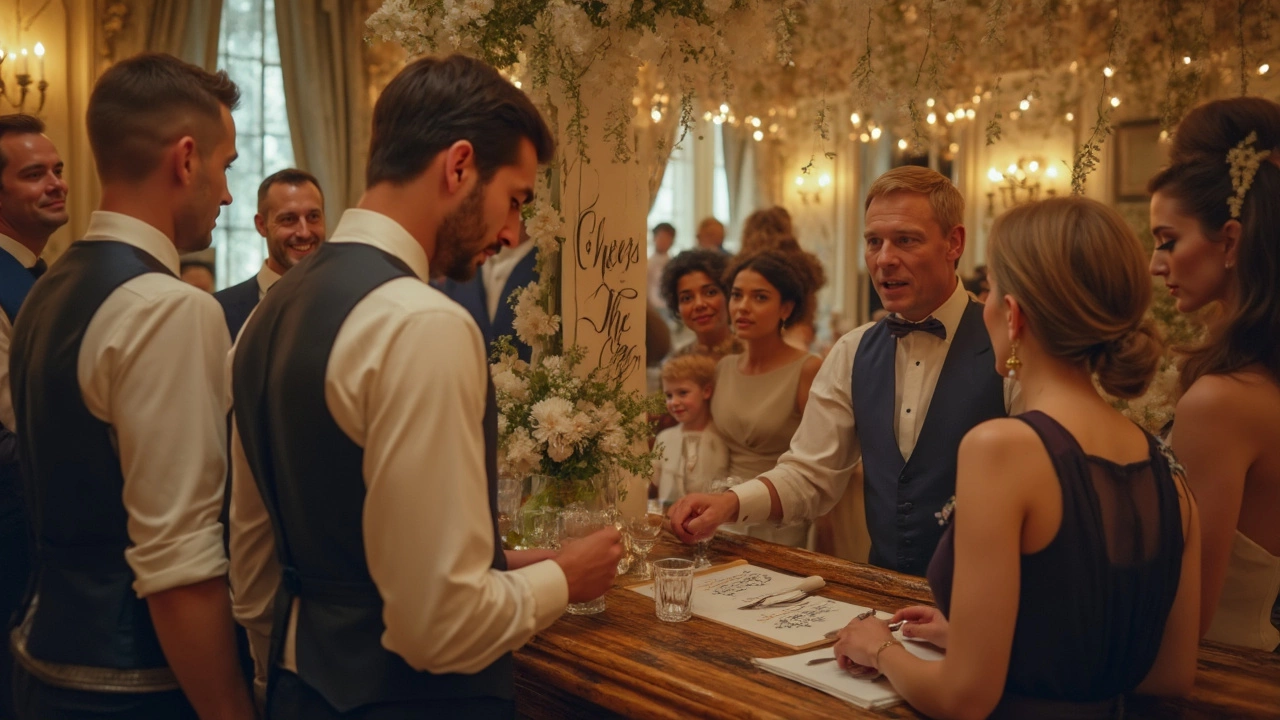Trying to figure out who really pays for the booze at a wedding? You’re definitely not alone. Plenty of couples get tripped up by the old-school rule that the groom’s family covers the alcohol bill—especially when budgets are tight and family traditions clash with reality.
Here’s what’s actually happening behind the scenes: that tradition started back when wedding costs were split very differently than they are now. It’s not a set rule, and these days, people are mixing things up based on what works for them (and their bank accounts).
If you’re dreading the money talk with your families, you’re in good company. Most couples today skip the script and have honest conversations about what everyone can afford. After all, the most important thing is making a plan that keeps everyone happy…and a little less stressed about the bar tab.
- The Origin of the Groom’s Family Paying for Alcohol
- Modern Weddings: How Alcohol Costs Get Handled
- Tips for Splitting the Bar Bill (Without Drama)
- Trendy Alternatives: BYOB, Drink Limits, and Cash Bars
The Origin of the Groom’s Family Paying for Alcohol
Ever wondered why people say the groom's family should pay for the wedding alcohol? It traces back to old-school wedding traditions, especially in the U.S. and UK, where wedding expenses had their own split: the bride’s family handled the bulk of the ceremony and reception, while the groom’s side covered certain extras—like the bar tab, rehearsal dinner, and, in some cases, even the DJ.
This split wasn’t random. The thinking was, if the bride’s family was already shelling out for dinner and flowers, asking the groom’s folks to pick up alcohol balanced things out financially. Some etiquette guides from the 1950s and earlier even outlined these rules, spelling out who owed what, down to the champagne for toasts.
Here’s a quick rundown of how things were “supposed” to go according to tradition:
- The bride’s family paid for the venue, food, décor, and most of the main event.
- The groom’s family covered beverages, the rehearsal dinner, and—sometimes—music or entertainment.
If you’re curious about how these costs used to shake out, check out this sample table that’s popped up in old etiquette books:
| Expense | Who Pays (Traditionally) |
|---|---|
| Flowers | Bride's Family |
| Dinner & Reception | Bride's Family |
| Alcohol | Groom's Family |
| Rehearsal Dinner | Groom's Family |
The main thing to know: these rules aren’t law. Times have changed, and people are way more flexible now about who pays for what. But this is where it all started—and explains why your aunt might still ask if the groom's family is picking up the tab for cocktails.
Modern Weddings: How Alcohol Costs Get Handled
If you’re wondering who covers the cost of alcohol at most weddings these days, the answer isn’t so clear-cut. The old tradition that the groom's family always pays just doesn’t fit most modern budgets or family setups. Plenty of couples just shake things up and split the cost, depending on what everyone feels comfortable with. According to a 2023 survey by The Knot, about 54% of couples reported that they footed the entire alcohol bill themselves, while only 18% said any parents paid for all alcohol—and almost no one strictly followed the groom’s family rule anymore.
There are several ways couples are handling the whole alcohol thing now:
- Family Split: Some divide the bill right down the middle between both families.
- Couple Pays: Many just pay for alcohol out of their own pocket, sometimes using part of their overall wedding budget.
- Contribution-Based: It's pretty common for families to chip in a fixed amount, and the couple covers the rest.
With the average open bar costing anywhere from $2,400 to $6,000 in the U.S., it’s not shocking that couples are looking at options. You might see wedding invites hinting at a limited bar or stating that only certain drinks will be provided free, while guests buy anything extra.
| Who Pays for Alcohol? | Percentage (%) |
|---|---|
| The Couple | 54 |
| Both Families Split | 21 |
| Parents of Groom | 6 |
| Parents of Bride | 12 |
| Other | 7 |
Bottom line? There isn’t just one right way to handle alcohol costs anymore. Couples are tossing out the old rules and having honest talks with family. Just set your budget, talk it through with everyone paying, and remember: it’s your wedding, so the bar (and bill) should work for your crowd.

Tips for Splitting the Bar Bill (Without Drama)
No one wants the wedding finances to turn into family drama, especially when it comes to the wedding alcohol tab. A little planning goes a long way, so here’s how people actually handle it—and keep things chill.
First, sit down with both families and talk numbers early. Don’t assume the groom’s family or anyone else will pick up the check—most modern weddings work out a plan before any contracts get signed. If someone has a strong opinion on what gets served, you can politely remind them there’s usually a cost attached.
- Split by headcount: One easy way is to break down the guest list. Each side can pay for the drinks based on their invited guests. If the bride’s family has more guests, they pay for their share, and the groom’s side does the same. It’s direct and fair.
- Split by type: Sometimes families agree that one pays for wine and beer, while the other covers liquor. For example, the groom's family might handle cocktails if that fits your crowd. This setup lets everyone contribute without confusion.
- Flat contribution: Some families prefer to just pick a dollar amount as their max spend. If the wedding alcohol budget is $5,000, maybe each side chips in $2,500 or whatever feels right.
There’s also the approach where the couple covers all costs and skips family contributions altogether, which takes away mixed expectations but may raise your total budget quickly.
| Method | How It Works | Good For |
|---|---|---|
| Headcount Split | Each family pays for their guest list’s drinks | Big, blended weddings |
| Type Split | One side pays beer/wine, other liquor | Families with strong drink preferences |
| Flat Contribution | Each family gives a set amount | Simple, low-drama approach |
| Couple Pays | Bride and groom cover everything | Modern, independent couples |
If you’re splitting with family, put everything in writing—an email is just fine—to keep expectations clear. No one wants surprise bills, and having all the details prevents hard feelings after the party’s over.
Also, check with your venue. Some hotels and event spaces charge by the hour, while others bill for what gets actually consumed. Knowing this upfront helps you manage requests from both families and keeps the bar bill from exploding.
Pro tip: Skip the mystery and ask your caterer or venue for average drink consumption rates. At U.S. weddings, it’s common to estimate one to two drinks per guest per hour. Being realistic with these numbers helps everyone relax, no matter who’s holding the tab.
Trendy Alternatives: BYOB, Drink Limits, and Cash Bars
Not every wedding couple or groom’s family wants to pick up the whole tab for alcohol, and that’s totally normal these days. You’ve got some clever workarounds that save money and cut down on stress about who pays for what.
Take BYOB weddings—especially popular with backyard receptions or venues that let you bring your own booze. This approach can save hundreds or even thousands of dollars, and it often means you get to serve exactly what you (or your guests) want. The only thing is, you usually have to hire a licensed bartender or get some kind of event insurance, so double-check your venue’s policy before stocking the coolers.
Drink limits are another lifesaver for couples watching the budget. Some couples go for a “beer and wine only” bar, which slashes costs way down compared to a full open bar with cocktails. Others offer a limited signature cocktail—think one fun drink that matches your theme, served alongside non-alcoholic options. That keeps things festive without hitting your wallet too hard.
Cash bars have a bit of a reputation, but they actually make life easier if families can’t agree or aren’t up for footing a big alcohol bill. With a cash bar, guests pay for their own drinks—just be sure to mention it up front on your wedding invitations so nobody’s caught off guard. It’s more common than you think: according to a 2024 survey from The Knot, about 18% of US weddings had at least a partial cash bar last year.
| Alternative | Average Savings | Key Consideration |
|---|---|---|
| BYOB | Up to $2,500 | Venue rules, need for licensed bartenders |
| Drink Limits | $1,000–$2,000 | May require specialty menu, guest expectations |
| Cash Bar | Unlimited (couple pays $0) | Etiquette: clear communication to guests |
Bottom line: talk through these options with both sides of the family. No matter what you decide, being honest about your budget—and sharing details early—keeps everyone happy and your wedding alcohol plan drama-free.
